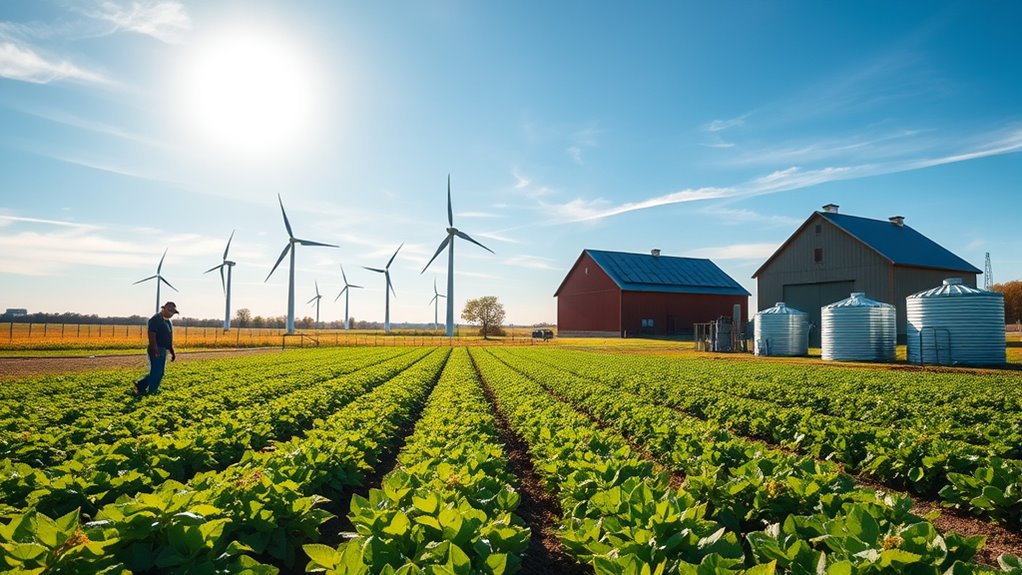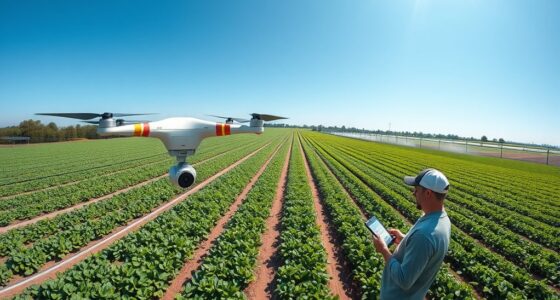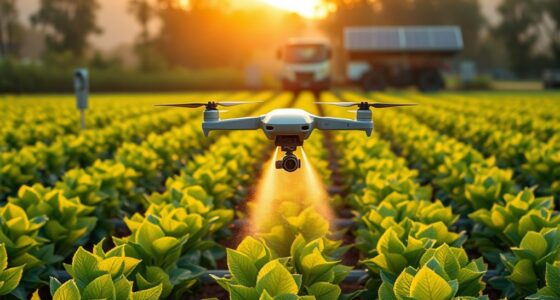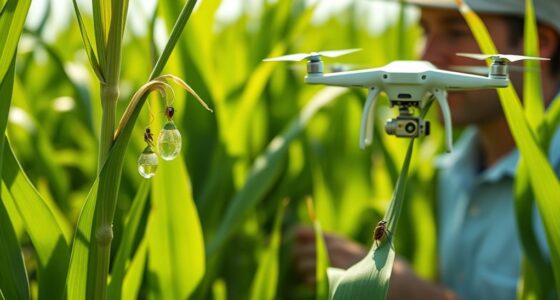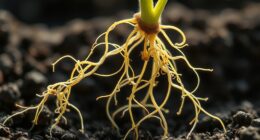Climate-smart farming practices are quickly gaining momentum as farmers adopt methods like conservation tillage, crop rotation, and cover cropping to boost soil health and reduce erosion. Water-saving techniques such as drip irrigation and rainwater harvesting help conserve resources, while new technologies like drones and precision agriculture optimize input use. Combining renewable energy sources and policy support further enhances sustainability. Keep exploring to discover how these innovations can transform your farming approach for a resilient future.
Key Takeaways
- Adoption of conservation tillage and cover cropping improves soil health and reduces erosion, supporting climate resilience.
- Use of advanced water management techniques like drip irrigation and rainwater harvesting enhances resource efficiency.
- Integration of precision agriculture and drone technology enables targeted interventions, reducing input waste.
- Growing emphasis on crop diversification and climate-resilient crops enhances farm adaptability to climate impacts.
- Policy incentives and farmer education programs promote widespread adoption of sustainable, climate-smart farming practices.
Techniques for Conservation Tillage and Soil Health
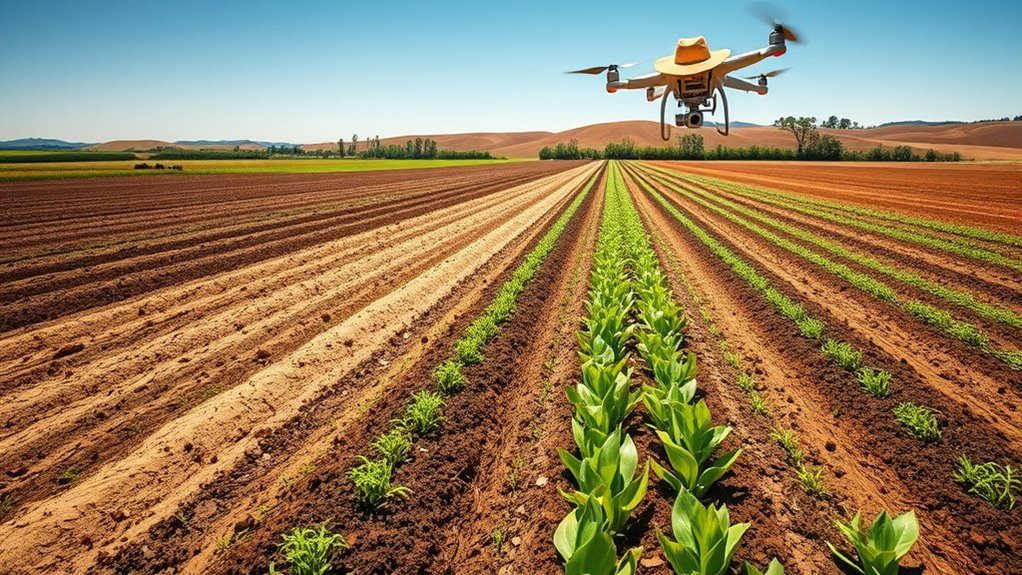
Conservation tillage techniques play a crucial role in maintaining soil health and promoting sustainable farming. By minimizing soil disturbance, you help preserve soil structure and moisture. Cover crop planting is an effective method; it protects the soil from erosion, adds organic matter, and enhances nutrient cycling. Incorporating cover crops during off-season periods keeps the soil covered and active. Compost application further boosts soil fertility by delivering essential nutrients and improving microbial activity. Regular use of soil monitoring tools can help farmers assess soil health and optimize their practices. Additionally, reducing reliance on heavy machinery decreases soil compaction and erosion risks. These practices reduce the need for chemical inputs and help lock carbon in the soil, fighting climate change. When you adopt conservation tillage, you’re not just improving crop yields but also fostering a resilient, healthy soil ecosystem that supports long-term sustainability.
Diversification and Crop Rotation Strategies
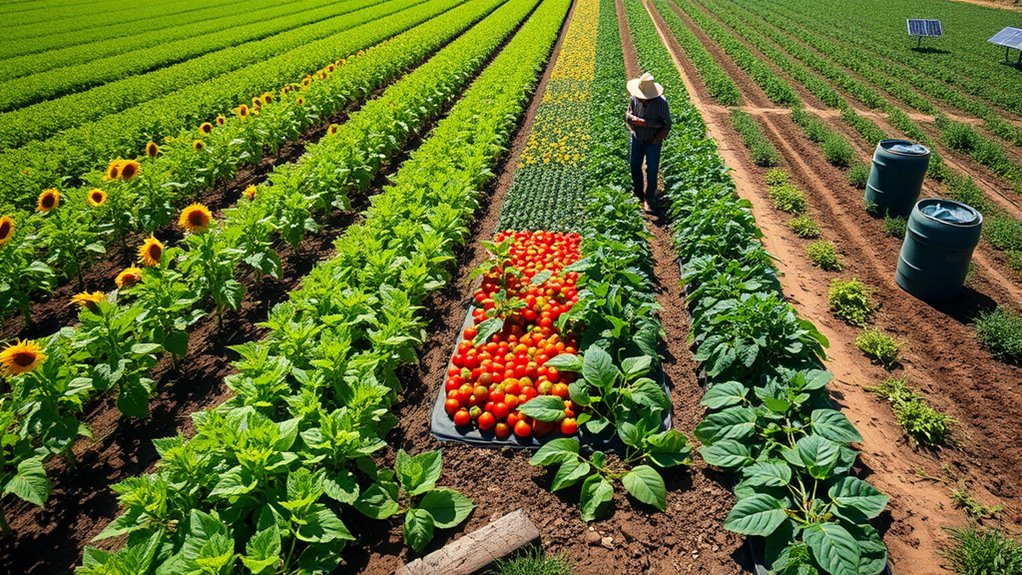
By rotating crops and introducing diverse plantings, you can improve your soil’s health and fertility naturally. These strategies also help you cut down on pest problems without relying heavily on chemicals. Implementing crop rotation and diversification can make your farm more resilient and productive over time. Additionally, incorporating nutrient-rich ingredients into your planting schemes can further enhance soil quality and boost crop yields. Using natural materials like compost and cover crops in your planning can support sustainable soil management. Embracing creative practice in planning your crop varieties can inspire innovative ways to optimize land use and resource management.
Enhances Soil Health
Implementing diversification and crop rotation strategies can considerably boost soil health by preventing nutrient depletion and breaking pest cycles. These practices promote better soil aeration, allowing roots to access oxygen more efficiently and reducing compaction. Incorporating organic amendments, like compost or cover crops, enriches the soil with nutrients and organic matter, enhancing microbial activity and structure. Rotating crops minimizes the buildup of harmful pests and diseases that target specific plants, maintaining a balanced ecosystem below ground. Diversification encourages a variety of root structures and depths, which improves soil porosity and water retention. Additionally, the high nutrient content of certain cover crops can further enhance soil fertility naturally. Employing soil management techniques such as reduced tillage can also help preserve soil structure and prevent erosion. Together, these strategies create resilient, healthy soils that support sustainable farming, increase productivity, and reduce the need for chemical inputs, aligning with climate-smart agriculture goals.
Reduces Pest Risks
Diversification and crop rotation are effective strategies to reduce pest risks in farming systems. By rotating crops, you break pest cycles and prevent infestations from establishing. Incorporating pest resistant crops enhances resilience, reducing the need for chemical controls. Additionally, integrating biological controls like beneficial insects helps manage pests naturally. These practices create a less favorable environment for pests, minimizing damage and promoting healthier yields. Understanding pest behavior can further optimize these integrated approaches. For example, knowledge of dog breeds can inform the selection of companion animals that support farm health and well-being. The table below highlights key benefits:
| Strategy | Benefit |
|---|---|
| Crop rotation | Disrupts pest life cycles |
| Pest resistant crops | Reduces pest damage without chemicals |
| Biological controls | Naturally suppresses pest populations |
| Diversification | Enhances ecosystem balance |
| Reduced chemical use | Lowers environmental impact |
Implementing proper monitoring techniques can further enhance pest management efforts. Together, these methods make your farm more resilient against pest threats.
Water Management Innovations and Practices

You can improve water efficiency on your farm by adopting advanced irrigation techniques that reduce waste and conserve resources. Installing rainwater harvesting systems allows you to capture and utilize natural water sources, decreasing reliance on external supplies. These innovations help you build a resilient, sustainable approach to water management amid changing climate conditions. Regularly assessing your water usage and implementing water-efficient irrigation can further optimize resource management. Additionally, choosing appropriate equipment tailored to your specific crop needs can enhance water conservation efforts.
Efficient Irrigation Techniques
Efficient irrigation techniques are essential for maximizing water use and minimizing waste on farms. Drip irrigation delivers water directly to plant roots, reducing evaporation and runoff. This method guarantees plants receive consistent moisture levels, supporting healthy growth. Soil moisture monitoring helps you determine the exact water needs of your crops, preventing over- or under-watering. By using sensors and real-time data, you can adjust irrigation schedules precisely, saving water and energy. These innovations make your irrigation system more targeted and effective. Implementing drip systems combined with soil moisture monitoring allows you to optimize water usage, improve crop yields, and promote sustainable farming practices. Incorporating Kia Tuning options like performance enhancements can also serve as a model for optimizing system efficiencies. Additionally, understanding water management strategies can further enhance your irrigation system’s effectiveness. Embracing these techniques is a smart step toward more efficient, climate-friendly agriculture.
Rainwater Harvesting Systems
Have you considered how rainwater harvesting can transform your water management practices? By collecting and storing rainwater, you can reduce reliance on groundwater and ensure a steady water supply during dry periods. This system supports drought-resistant crops, helping your farm remain productive despite changing climate conditions. Additionally, rainwater harvesting promotes soil conservation by minimizing runoff and erosion, preserving valuable topsoil. Implementing these systems can lower your overall water costs and boost resilience against droughts. You can design simple or advanced setups tailored to your farm’s size and needs. As a result, you’ll enhance water efficiency, strengthen your crop variety choices, and contribute to sustainable farming. Rainwater harvesting isn’t just an investment in water management; it’s a step toward climate-smart, resilient agriculture. Incorporating water management innovations such as integrated water systems can further optimize resource use and support long-term farm sustainability.
Use of Technology and Precision Agriculture
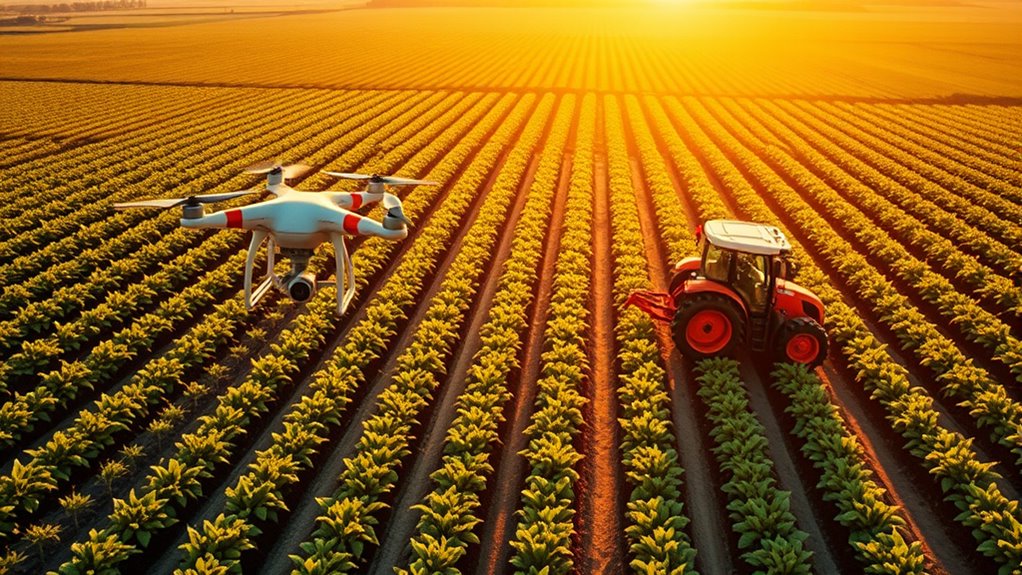
Technology and precision agriculture are transforming farming practices by enabling you to monitor and manage your fields more accurately. Drone monitoring provides real-time aerial views, helping you identify issues like pest infestations or water stress early. Data analytics allows you to interpret this information, optimizing input use such as water, fertilizers, and pesticides. With these tools, you can make informed decisions that increase yields while reducing environmental impact. Sustainable resource management is supported by these innovations, helping you meet climate-smart goals. Precision farming techniques also help you target specific areas, avoiding waste and improving efficiency. By integrating technology into your operations, you not only boost productivity but also support climate-smart goals through Sustainable resource management. Embracing drone monitoring and data analytics puts you at the forefront of innovative, resilient farming practices. Online resources can guide you through implementing these technologies effectively.
Climate-Resilient Crop Selection
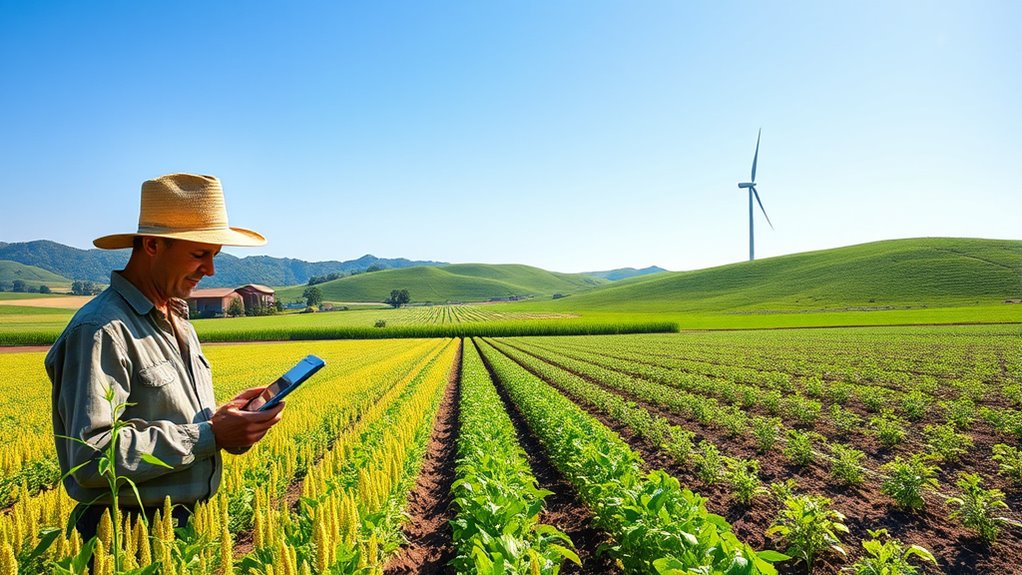
Choosing the right crops is essential for building resilience against climate change. To do this effectively, you should consider climate-resilient crop selection, focusing on varieties that withstand drought, floods, and extreme temperatures. Genetic modification plays a key role here, allowing you to develop crops with enhanced tolerance and yield stability under changing conditions. These crops can help you adapt to unpredictable weather patterns and reduce crop failure risks. Additionally, selecting resilient crops improves your market access by meeting increasing demand for sustainable and climate-smart produce. By choosing crops optimized for future climate scenarios, you can secure your farm’s productivity and profitability. Emphasizing resilient crop selection guarantees your farming practices remain sustainable and competitive amid the evolving climate landscape. Incorporating climate-smart strategies into your farming practices can further enhance your resilience and long-term success. Furthermore, understanding climate adaptation techniques can help you implement proactive measures to protect your crops from climate-related stresses and leverage advanced breeding techniques to enhance resilience.
Integrating Renewable Energy Sources
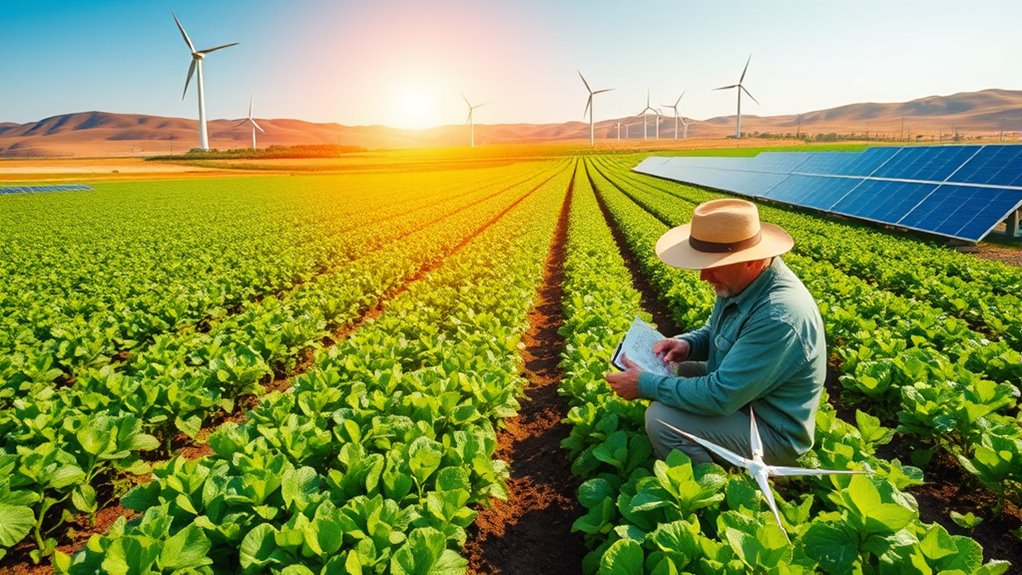
Why not harness the power of renewable energy sources to make your farm more sustainable? Installing solar photovoltaics can generate clean electricity, reducing reliance on fossil fuels and lowering energy costs. Wind turbines are another excellent option, especially if your farm is in a windy area; they produce power efficiently and help cut emissions. Integrating these energy sources not only decreases your carbon footprint but also enhances your farm’s resilience during power outages. Plus, excess energy can often be stored or sold back to the grid, creating additional income. Shifting to renewable energy is a proactive step toward renewable energy sources climate-smart farming, helping you operate more sustainably while saving money long-term. Embracing solar and wind solutions makes your farm more environmentally friendly and economically viable.
Policy Support and Farmer Education Initiatives
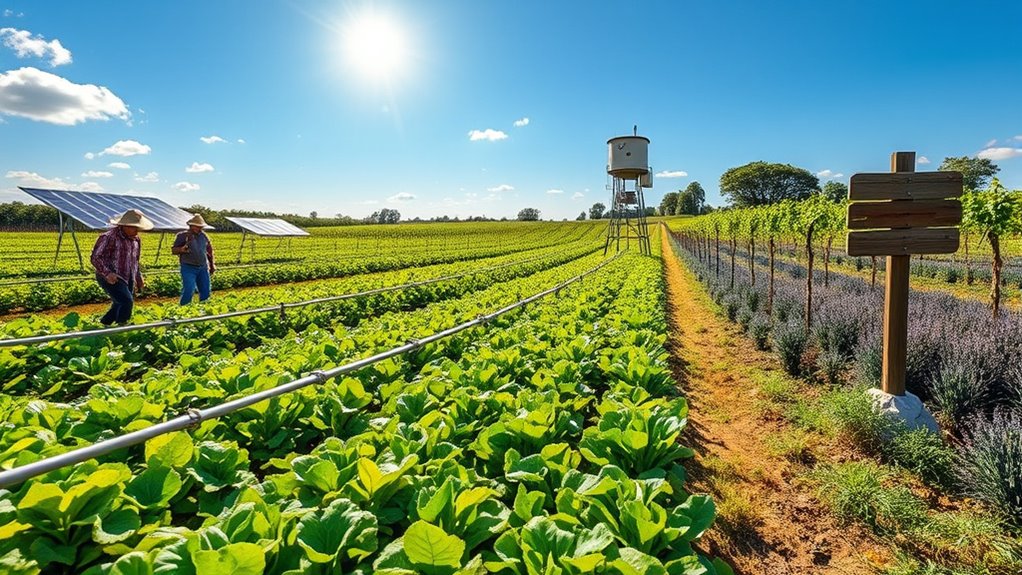
Effective policy support and targeted farmer education are essential for promoting climate-smart farming practices. Policy incentives, such as subsidies and financial rewards, motivate farmers to adopt sustainable methods. These incentives reduce costs and encourage innovation, making it easier to implement climate-smart solutions. Additionally, farmer training programs play a crucial role by providing the knowledge and skills needed to adopt new practices confidently. Well-designed education initiatives help farmers understand the benefits of conservation tillage, crop diversification, and efficient water use. When policies align with training efforts, farmers are more likely to embrace climate-smart techniques, leading to increased resilience and productivity. By combining effective policy incentives with extensive farmer education, you can support widespread adoption of sustainable agriculture that benefits the environment and local communities.
Frequently Asked Questions
How Do Climate-Smart Practices Impact Long-Term Farm Profitability?
Climate-smart practices boost your long-term farm profitability by making your operations more resilient. Implementing sustainable water management guarantees you use water efficiently, reducing costs and resource waste. Crop diversification spreads risk, helping you adapt to changing conditions and market demands. These strategies not only protect your farm from climate impacts but also improve yields and income over time, securing your farm’s future and increasing profitability in the long run.
What Are the Initial Costs of Adopting Climate-Smart Farming Techniques?
Think of adopting climate-smart farming techniques as planting a new orchard. Your initial investment covers costs like upgraded equipment, soil health improvements, and new technology. While these upfront expenses can be significant, financial incentives from government programs and grants can help offset them. Over time, these investments grow, leading to healthier yields and more resilient farming, making the initial costs a worthwhile seed for future success.
How Can Small-Scale Farmers Access Training and Resources?
You can access training and resources through local agricultural extension offices, which often offer workshops and materials tailored for small-scale farmers. Look for government programs or NGOs that focus on sustainable farming techniques. Joining cooperatives or online platforms also helps improve resource access and learning opportunities. By actively seeking these options, you’ll gain the knowledge and tools needed to implement climate-smart practices effectively.
What Are the Barriers to Widespread Adoption of These Practices?
Oh, sure, everyone loves change—except when it involves farmer skepticism and technological limitations. These barriers make it tough for you to adopt climate-smart practices widely. Skeptical farmers doubt new methods’ benefits, and limited access to advanced tech hampers progress. Overcoming these hurdles requires education, affordable tools, and trust-building. Only then can you fully embrace sustainable farming, turning doubts and tech gaps into opportunities for a greener future.
How Do Climate Policies Influence Farmer Participation in Sustainable Practices?
You see that climate policies substantially influence farmer participation in sustainable practices through policy incentives that motivate change. When policies offer financial support, technical assistance, or recognition, they boost farmer engagement. These incentives encourage farmers to adopt climate-smart methods, making sustainability more accessible and appealing. Ultimately, effective policies create an environment where farmers feel supported and motivated to implement practices that benefit both their operations and the environment.
Conclusion
As you embrace climate-smart farming, remember that every action you take is a crucial stitch in the fabric of our planet’s future. Like a ripple in a pond, your sustainable choices can inspire others to follow suit. With innovation, resilience, and dedication, you can turn challenges into opportunities, ensuring a healthier Earth for generations to come. So, will you be the change-maker our planet needs today?
